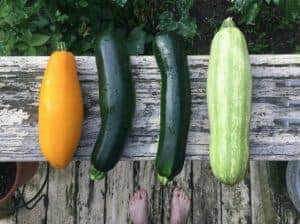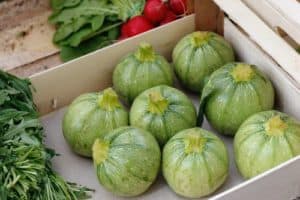Few vegetables remind me of the taste of summer like zucchini does. I like frying them and roasting them, but people use them in so many dishes from zucchini pasta, to summer salads, to stuffed zucchinis. If you have no more in-ground space in your garden, or you want to grow some vegetables on your deck or balcony, or maybe you want to grow vegetables indoors, zucchinis are one of the best choices because of how easy it is to grow and how productive it can be.
Despite their large size, zucchinis can seamlessly adapt to growing in a pot. Whether starting from seed or buy a plant, transplant into a 5-gallon (19-L) pot filled with well-draining potting mix. Keep the soil moist but don’t overwater. Zucchini is a heavy feeder so it needs rich potting mix and extra fertilizer throughout the growing season. If several zucchini plants are grown outdoors, manual pollination usually isn’t required, but to guarantee a high yield, you can manually pollinate female zucchini flowers. However, you can avoid pollination altogether by planting parthenocarpic varieties of zucchini plants, which produce zucchinis without any pollination—good for greenhouses, balconies, indoor growing, or just to maximize yield out in the garden. Zucchinis can be picked at any time, but are normally picked between 4 and 10 inches (10-25 cm).
On this page:
Pot Size for Zucchinis
Although zucchinis are large plants, they don’t actually need an extremely large pot since their roots don’t travel too deep. A 5-gallon (19-L) container is enough for one zucchini plant, and I have gotten away with 3-gallon containers. Note that the smaller container you use, the smaller your plant will be and the more frequently you will have to water your zucchinis.
Fill your containers with a well-draining potting mix and ensure there are enough drainage holes on the bottom. Zucchinis love water but hate drowning in it and easily get root rot.
Can I Grow Zucchini in a 5-Gallon Bucket?
Yes, and in fact, a 5-gallon bucket is the perfect size for a zucchini plant, since it has some extra depth to hold more water and therefore won’t dry out as quickly as regular containers. Just make sure to drill adequate drainage holes all along the bottom and the sides near the ground, so there is enough excess water flow. Any 5-gallon bucket will do, but black buckets absorb more heat, which might be great in the spring and fall, but could stress out your plants in the heat of the summer. If you go with black buckets, just keep that in mind and react accordingly if you notice the buckets are getting too hot. I’ve used aluminum foil taped around the sides of black buckets to reflect some of the sun and keep the soil from overheating.
Light Requirements of Zucchini
Zucchini is a sun-loving plant and needs at least 6 to 8 hours of full sun every day. The more sun, the better. The only times you should keep your zucchinis in pots in shade or partial shade is when you take out the little seedlings for the first few days, to get them used to the outdoor conditions (called hardening off) or if the sun is too strong and your plants are drying out too quickly and getting heat stressed.
If you are growing indoors, use a strong LED light kept on 12 to 18 hours a day.
How to Grow Zucchini in Containers
Direct Sowing vs. Transplanting
Zucchinis are relatively quick to sprout and famously vigorous once they start growing, so whether you want to direct sow or transplant is up to you. Personally, I prefer transplanting because young, tender seedlings are often vulnerable to slug and other herbivore (i.e. rabbit) damage. I’ve had something—I suspect slugs—completely decapitate my little zucchini seedlings when I was direct seeding. Once zucchinis get large enough, they’re too tough and inedible for most pests (more on that later).
Another reason I like to start my zucchinis indoors, even if I’m growing them in a pot outside is that I can do succession planting. Most of my zucchinis start dying at some point in mid summer, getting taken by powdery mildew and cucumber beetles. But after the pest pressure from the beetles is gone, you can take out the dead zuccs and plant a new crop of them. Zucchinis mature really fast, often producing fruit in less than two months, so if you get your first frost at the end of October, you could plant a fall crop of zucchinis in July or August and get more harvests into late September up to the first killing frost.
Sowing Zucchini
Regardless of how you decide to start your zucchinis, sow your seeds about 1/2 inch to 1 inch (1.25-2.5 cm) deep and ensure the potting mix is kept moist. Zucchinis take about 7 to 14 days to germinate, but if I plant a few seeds indoors where it’s warm, the first ones start popping up in less than a week. Ensure the growing medium stays moist throughout the early stages of your zucchini’s growth but isn’t sopping wet.
Taking Care of Zucchini Seedlings
The first two, kind of round leaves, that emerge are the seed leaves, or cotyledons. Once they poke through, continue to water your zucchini seedlings frequently but again, without flooding the roots in water. If you are starting indoors, I recommend using fluorescent lights (CFL bulbs or the long bulbs) or LED grow lights a few inches above them so they don’t get leggy.
Once your seedlings start putting out true leaves (which have a typical zucchini leaf shape), you can give them a very dilute feeding of liquid fertilizer if your seed starting mix, potting mix, or sterile medium doesn’t have any nutrients in it.
My rule of thumb for the cucurbit family (zucchinis, cucumbers, squash, watermelons, etc.) is to transplant to it’s final pot after the seedling has at least two true leaves.

How to Get Zucchini Fruits Instead of Just Flowers
Zucchinis are monoecious, meaning they have both female and male parts, but on separate flowers. That means they have two types of flowers: male pollen-producing flowers and female fruiting flowers. You can tell the difference because male flowers are only attached to a thin stalk while female flowers have a tiny zucchini behind them. If pollen from a male flower makes it into the middle part (the stigma) of the female flower, pollination occurs and the tiny zucchini behind the female flower will rapidly swell.
The problem is that sometimes you have female flowers and male flowers opening up at different times. I always recommend growing multiple zucchinis so you can increase your chances of pollination. But if you are growing up on a balcony, in a greenhouse, or indoors, you might not have the natural pollinators around to pollinate them.
However, you can pollinate your zucchinis yourself. It’s easy. Male and female flowers open early in the morning. If female and male flowers are both open, you can remove the male flower, take off the petals, and dab the pollen-producing part into the center of the female flower. Alternatively, you could take a brush or cotton swab and collect pollen, then dab it all over the center of the female flower.
If you only can grow one zucchini plant, or you want to grow more of them and maximize their yield, grow a parthenocarpic variety of zucchini.
Highly Recommended: Growing Parthenocarpic Zucchini
Parthenocarpic zucchinis are ones that will produce fruit without pollination. In some cases, they also produce more female flowers. That means you will have guaranteed yields even if you’re growing it in a sealed off greenhouse or your basement. My favorite parthenocarpic varieties are Partenon (dark green) and Cavili (light green). If you grow even 2-3 of these, your biggest problem will be thinking of what to do with all the zucchinis you’ll be picking every few days.
Read more about growing parthenocarpic zucchini and recommended varieties.
Fertilizing Zucchinis in a Pot
Zucchinis are prolific growers. Once they have their first 2-3 true leaves, they should rapidly start throwing out new shoots and then flowers. You can apply a slow-release fertilizer at the beginning of the season and reapply it later according to the instructions. I like Jobe’s tomato spikes for all my fruiting vegetables (tomatoes, peppers, zucchinis, cucumbers, eggplants, etc.), and it’s pretty cheap. If you use liquid fertilizer, you can use any kind of balanced NPK fertilizer but if you want, you can switch to a “bloom” or “fruiting” formula with less N and more P and K as you start getting fruit; apply liquid fertilizers every 7-14 days once the zucchini is established.
If you use new potting mix, it likely already has enough nutrients inside (check the bag) to keep the plant growing for a month or so, but it will quickly deplete it of nutrients, so I would still go with fertilizing it after that first month.
Do Zucchini Plants Need Support?
Zucchini doesn’t vine out the way cucumbers do, but you will notice your zucchini plants flopping over the side of the as the main stem continues growing. There are several benefits to staking zucchini plants, such as reducing disease (powdery mildew) and saving space.
Recommended Zucchini Varieties for Growing in Pots
Regular Zucchini |
Parthenocarpic Zucchini (Requires NO Pollination) |
| Black Beauty | Partenon F1 |
| Goldy | Cavili F1 |
| Romanesco | Burpee Sure Thing F1 |
| Jackpot F1 | Venus F1 |
All of the above zucchini varieties are perfect for growing in pots, but as mentioned before, if you want to guarantee a good harvest or you can’t grow many plants, you should try one of the parthenocarpic varieties. The ones in bold are my personal favorites.
Harvesting Zucchini in Pots
You can harvest zucchini at any stage. Some people take those little baby zucchinis and cook them. Other people let a few zucchinis get fully mature and cook them like a winter squash. But for general use, depending on the variety, pick zucchinis between 4 and 10 inches (10-25 cm).

